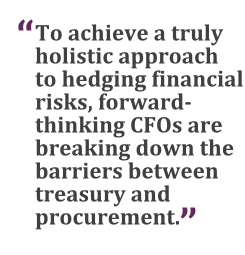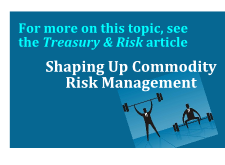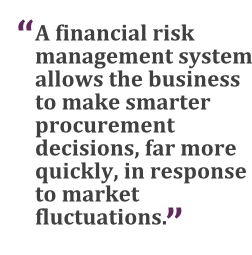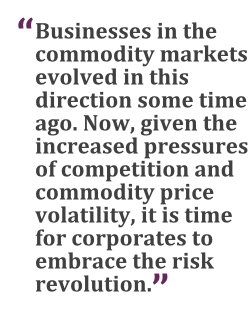 War makes for strange bedfellows. Case in point: In the corporate battle against currency and commodity risks, companies are increasing collaboration between, and even merging, the treasury and procurement functions.
War makes for strange bedfellows. Case in point: In the corporate battle against currency and commodity risks, companies are increasing collaboration between, and even merging, the treasury and procurement functions.
It's a practice that is sensible and is here to stay. That's partly because businesses in many diverse industries face considerable exposure to commodity risks through their supply chain. An automaker may take a hit to earnings thanks to an unexpected spike in metals prices. A major manufacturer of cleaning products may find its slim margins wiped out due to an uptick in chemical prices. A coffee house chain might fall short of consensus earnings estimates because of higher dairy costs, and so on. In industries where pass-through of raw materials prices is difficult, commodity price volatility can have a profound effect on the bottom line. The manufacturing, retail, and food and beverage sectors are particularly sensitive to commodity price swings.
The other key driver of increased alignment between treasury and procurement is foreign exchange (FX) risk. Large multinationals tend to be hit particularly hard, but FX exposures can damage the financial statements of any company with a supply chain and/or distribution channels spread across multiple currency zones.
Increasing Commodity Price Volatility
Historically, businesses have usually managed currency and interest rate risks separately from commodity risks because their treasury and procurement functions have operated separately. Interest rates and foreign exchange have historically been core to the function of corporate treasury groups, so many treasury teams manage currency and interest rate risks through financial hedges.
Meanwhile, the same treasury staff may have little to no visibility into the company's commodity price risks. And if the procurement division manages physical commodity exposures, it usually does so in an unsophisticated way—for instance, by locking suppliers into a price for a fixed period when prices seem low. Moreover, the procurement group typically runs commodity risk management programs using blunt, antiquated systems, such as dozens of spreadsheets into which data must be entered manually.
 This scenario was never ideal, but it was manageable when commodity price volatility was relatively low. However, times have changed. Over the past decade, international commodity markets have entered a new era of high volatility. Recent sharp movements in the price of crude oil provide a timely illustration. After Brent Crude peaked at US$115 per barrel in June 2014, rising supplies combined with tepid global demand sent the price on a nosedive; it slumped by more than 50 percent, to a low of $45 a barrel in January of this year. News indicating a pullback in drilling and investment, along with supply disruptions in oil-producing countries, has since triggered a modest rebound. The International Energy Agency has warned that this degree of volatility isn't going away anytime soon.
This scenario was never ideal, but it was manageable when commodity price volatility was relatively low. However, times have changed. Over the past decade, international commodity markets have entered a new era of high volatility. Recent sharp movements in the price of crude oil provide a timely illustration. After Brent Crude peaked at US$115 per barrel in June 2014, rising supplies combined with tepid global demand sent the price on a nosedive; it slumped by more than 50 percent, to a low of $45 a barrel in January of this year. News indicating a pullback in drilling and investment, along with supply disruptions in oil-producing countries, has since triggered a modest rebound. The International Energy Agency has warned that this degree of volatility isn't going away anytime soon.
It's absurd for a corporate treasury to routinely hedge currency and interest rate risks while ignoring commodity price risk. A company may have been greatly affected by the recent dramatic swings in the price of crude oil, but if treasury isn't involved in managing those risks, the organization probably did not have hedges in place to protect itself. Yet the same company may have hedges on short-term interest rates, even though three-month LIBOR rates have been well below 1 percent for some time. This scenario is common, and it's problematic for financial risk management. That's not to say that hedging short-term interest rates is unnecessary, but rather to point out that when treasury doesn't make commodity risk management a priority, it may be subjecting the company to significant exposures.
Oil and energy aren't the only volatile commodities at the moment. Although commodities typically tend to be more volatile than other asset classes, over the past seven years or so, the market has seen larger-than-usual price swings. From the boom in precious metals after the financial crisis to skyrocketing food prices resulting from droughts and heat waves, these are uncertain times. Global macroeconomic factors suggest that this level of volatility may be the new norm. Continued population growth, ongoing industrialization of frontier and developing economies, and a rapidly growing middle class all point to rising demand against the backdrop of a fairly static production base for various commodities. This will inevitably result in a market that is very sensitive to events affecting supply.
Impact of Globalization on Risk Management
 Risk is expanding on an international scale, as well. The increasingly international nature of trade has spawned new risk factors that can very quickly turn commodity holdings into a strong liability. Consider, for example, the effect that Chinese economic announcements have on the price of copper. For a cable company, the influence of the Chinese government over the copper market introduces another layer of complexity to risk management. China has also become one of the world's largest consumers of steel because of its construction needs. This makes the country a large consumer of metallurgical coal as well; that's the more expensive type of coal that is used in steel production. So even a slight economic uptick or downtick in the Chinese economy can move the needle on the demand for, and price of, multiple commodities.
Risk is expanding on an international scale, as well. The increasingly international nature of trade has spawned new risk factors that can very quickly turn commodity holdings into a strong liability. Consider, for example, the effect that Chinese economic announcements have on the price of copper. For a cable company, the influence of the Chinese government over the copper market introduces another layer of complexity to risk management. China has also become one of the world's largest consumers of steel because of its construction needs. This makes the country a large consumer of metallurgical coal as well; that's the more expensive type of coal that is used in steel production. So even a slight economic uptick or downtick in the Chinese economy can move the needle on the demand for, and price of, multiple commodities.
If a butterfly flapping its wings on one continent can cause a tsunami in another part of the world, it pays to notice when there are a lot of butterflies in the air. Companies with poor commodity risk management practices are more likely than ever before to be caught out by price swings, losing margin and/or market share due to a commodities market surprise. On the flip side, businesses that manage their commodity risk in a centralized and sophisticated manner have an increased chance of gaining an edge over rivals that don't. The classic example of using commodity risk management to profound advantage comes from Southwest Airlines. During the mid-2000s, Southwest locked in fuel prices at a low level ahead of a sharp uptick in prices. As a result, it was the only consistently profitable U.S. airline during the middle of the last decade, thriving while its rivals were forced to make serious cutbacks.
International trade and the ease of cross-border deals will cement complexity and interdependence in commodity exposures as permanent considerations in doing business globally. Likewise, growth in international trade has increased currency risk as well. A company may need to hold several different currencies at once in order to get its basic business done. For example, it might buy steel from a supplier in the United States, rubber from Brazil, and plastic from China—and it might use three different currencies to do that.
Proper corporate governance requires a company to account for its holdings in different currency markets and to reconcile these often-fluid exposures with changes in exchange rates. As we saw in mid-January with the de-pegging of the Swiss franc from the euro, being caught with too much exposure to a single currency can create large losses very quickly.
Holistic Financial Risk Management
Simple hedging strategies that involve purchasing derivatives to offset risks can be beneficial. But in order to be truly effective, decisions around hedging for commodity, currency, and interest rate exposures need to be made within the context of a companywide, holistic approach to risk management. This allows for a more thoughtful approach to hedging—one that recognizes and accounts for the myriad complex interrelations between risks.
 For example, if a manufacturer that is reliant on resin uses minimal hedging strategies, that decision may prove problematic during periods of sharply rising prices. Most processors are naturally short on the resin price. They could mitigate the risk by buying crude oil derivatives, as resin prices are often highly correlated with crude oil prices. A similar situation arose recently in the market for ethanol fuel additives in the United States. The use of corn-based ethanol additive in gasoline meant that corn prices increased, which drove up food prices across the board.
For example, if a manufacturer that is reliant on resin uses minimal hedging strategies, that decision may prove problematic during periods of sharply rising prices. Most processors are naturally short on the resin price. They could mitigate the risk by buying crude oil derivatives, as resin prices are often highly correlated with crude oil prices. A similar situation arose recently in the market for ethanol fuel additives in the United States. The use of corn-based ethanol additive in gasoline meant that corn prices increased, which drove up food prices across the board.
Finance executives who manage their company's exposure to these types of risks also have to take into account regulatory issues. Like trade, regulations have become more global in scope, so finance needs to ensure that they are in compliance with a growing roster of cross-border rules. And like prices of commodities or the value of currencies, the regulatory environment is constantly in flux. Regulatory changes may move more slowly than prices, but because laws and rules are subject to the political whims of various electorates and the political fortunes of world leaders, regulatory risk management is a must on the finance manager's to-do list.
 Companies need strong controls around operations; enterprise data management; data aggregation; and reporting in the correct format, structure, and timing. Regulatory risk management can also be supported through partners and trusted advisers, whose role it is to interpret international regulatory requirements and map these to individual client situations.
Companies need strong controls around operations; enterprise data management; data aggregation; and reporting in the correct format, structure, and timing. Regulatory risk management can also be supported through partners and trusted advisers, whose role it is to interpret international regulatory requirements and map these to individual client situations.
To achieve a truly holistic approach to hedging financial risks, forward-thinking CFOs are breaking down the barriers between treasury and procurement. They're integrating the two functions in a way that gives the CFO a single, sophisticated, and timely view of commodity, currency, and interest rate risks across the enterprise.
Procurement Planning Driven by Finance Data
Likewise, the procurement function becomes more effective when it works closely with the treasury team. Many global companies have adopted specific operational practices to address issues of data consistency and transparency between finance and procurement. For years, sales and operations planning (S&OP) systems have integrated information from sales and demand channels with data from manufacturing or production planning. This approach leads to the capability to “make only what we can sell,” as opposed to making a predetermined quantity of product and then asking sales to sell what has been made.
In the 2000s, S&OP solutions evolved into integrated business planning, or IBP. The growth of global enterprise resource planning (ERP) platforms has resulted in copious amounts of available data within the typical company, but getting value from this data may still pose significant challenges. Many organizations have multiple ERP instances, which are not necessarily standardized or homogenized, and the data is widely dispersed internally across ERP modules and offices. As a result, the team managing raw materials procurement may be working off of data and estimates that are outdated and inaccurate, storing crucial information in a spreadsheet that must be updated manually.
When the procurement team's data is inaccurate, the company will likely buy too much or too little of crucial component parts, leading to overstocking or understocking of materials. This is why it's crucial for IBP to include finance and/or the office of the CFO. Procurement needs to be getting data directly from the group responsible for creating the annual budget or plan based on corporate sales/revenue forecasts, as well as spending for both direct and indirect costs.
Best practices tie performance of the procurement function to the group's ability to secure prices that are better than the prices the company's competitors are getting. In a bear market for raw materials, where input prices are in a longer-term downward trend, procurement performance can be achieved naturally, without much specialized skill or active management. However, when prices rally, with longer-term upward pressure on prices, the requirements for achieving better-than-peers prices is a bigger challenge.
Technology Infrastructure to Support Treasury-Procurement Connection
When treasury and procurement act on timely, accurate, and standardized data that comes from a single enterprise-risk data source, both groups will have more transparency around input prices, drivers of corporate profitability, and margin management, as well as the opportunity to smooth out commodity price volatility using the precisely chosen hedges. Of course, to reach this state of collaboration, the company must install the right technology infrastructure. Legacy ERP systems are no longer fit for the purpose; many companies today are adopting best-of-breed software that integrates with their ERP platform but provides very targeted financial risk management capabilities.
 When selecting such a system, keep in mind that making the right investment will involve both tactical and strategic considerations. A company needs to identify a business case that can bring business benefits and payback, ideally within one year following the system's go-live date. It is critical to benchmark the current state of communication between procurement and finance, and to look at all the factors driving bottom-line profitability that the financial risk management software might be able to address, including ongoing cost penalties.
When selecting such a system, keep in mind that making the right investment will involve both tactical and strategic considerations. A company needs to identify a business case that can bring business benefits and payback, ideally within one year following the system's go-live date. It is critical to benchmark the current state of communication between procurement and finance, and to look at all the factors driving bottom-line profitability that the financial risk management software might be able to address, including ongoing cost penalties.
Every company will have different functionality needs from a financial risk management system. Some of these systems offer full treasury functionality—including support for an in-house bank, cash sweeping, cash pooling, management of minimum and maximum account balances, SWIFT payments capabilities, integration with execution platforms such as 360T, and support for global currency and hedging instruments.
Whether or not they're looking for a full-fledged treasury management system, companies shopping for a financial risk management solution need to make sure the software's core commodities functionality addresses data management issues in the areas of demand management, sales forecasting, procurement and inventory management, and physical commodity management—including mapping procurement contracts within the system to track commodity exposures and hedging. Companies that want to be able to use hedge accounting should also make sure the software can manage data around the efficiency of hedges; hedge allocation and reporting; and reporting on various risk metrics, such as cash flow at risk, earnings at risk, and budget at risk.
Companies should also evaluate the ability of financial risk management solutions to provide scenario modeling and other appropriate analytics tools, such as spend analysis or inventory and SKU management. Even if an organization feels it doesn't need all this functionality today, decision-makers should be sure the new system will provide adequate insights to support the company into the future, when it may require more agility in its strategic business capabilities.
Properly implemented, a financial risk management software system allows the business to make smarter procurement decisions, far more quickly, in response to market fluctuations. It also opens the door to the use of sophisticated analysis that can help the organization select optimal hedges to match its unique commodity-related financial risks. For a business previously reliant on spreadsheets, such a system can also pay dividends in terms of man-hours and reduced operational risk and lower error rates—all of which translates directly into an improved bottom line.
Businesses active in the commodity markets—the energy companies, merchant traders, and utilities of this world—evolved in this direction some time ago. Now, given the increased pressures of competition and high commodity price volatility, it is time for corporates to embrace the risk revolution.
———————————–
 Julian Eyre is a commodities and corporate treasury specialist at OpenLink. With over 15 years' experience across global banks, commodities, and corporates—both business and technology—Eyre has worked with clients to define tactical and strategic solutions across trading, risk, treasury, and procurement operations.
Julian Eyre is a commodities and corporate treasury specialist at OpenLink. With over 15 years' experience across global banks, commodities, and corporates—both business and technology—Eyre has worked with clients to define tactical and strategic solutions across trading, risk, treasury, and procurement operations.
© Touchpoint Markets, All Rights Reserved. Request academic re-use from www.copyright.com. All other uses, submit a request to [email protected]. For more inforrmation visit Asset & Logo Licensing.



